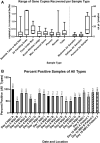Aerosol and surface contamination of SARS-CoV-2 observed in quarantine and isolation care
- PMID: 32728118
- PMCID: PMC7391640
- DOI: 10.1038/s41598-020-69286-3
Aerosol and surface contamination of SARS-CoV-2 observed in quarantine and isolation care
Erratum in
-
Author Correction: Aerosol and surface contamination of SARS-CoV-2 observed in quarantine and isolation care.Sci Rep. 2020 Aug 12;10(1):13892. doi: 10.1038/s41598-020-70939-6. Sci Rep. 2020. PMID: 32782290 Free PMC article.
Abstract
The novel severe acute respiratory syndrome coronavirus 2 (SARS-CoV-2) originated in Wuhan, China in late 2019, and its resulting coronavirus disease, COVID-19, was declared a pandemic by the World Health Organization on March 11, 2020. The rapid global spread of COVID-19 represents perhaps the most significant public health emergency in a century. As the pandemic progressed, a continued paucity of evidence on routes of SARS-CoV-2 transmission has resulted in shifting infection prevention and control guidelines between classically-defined airborne and droplet precautions. During the initial isolation of 13 individuals with COVID-19 at the University of Nebraska Medical Center, we collected air and surface samples to examine viral shedding from isolated individuals. We detected viral contamination among all samples, supporting the use of airborne isolation precautions when caring for COVID-19 patients.
Conflict of interest statement
The authors declare no competing interests.
Figures


References
-
- Morawska L. Droplet fate in indoor environments, or can we prevent the spread of infection in Indoor Air 2005. In: Proceedings of the 10th International Conference on Indoor Air Quality and Climate (eds Yang, X., Zhao, B. & Zhao, R.) 9–23 (Tsinghua University Press, 2006). - PubMed
Publication types
MeSH terms
Substances
LinkOut - more resources
Full Text Sources
Other Literature Sources
Research Materials
Miscellaneous

